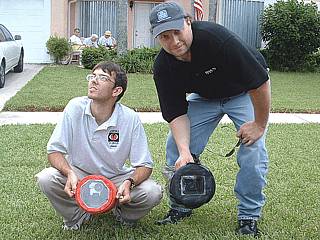Tom Mitchell
EF1
I was studying at Ryukyu University and living in the dorms in Okinawa at the time (and I have since returned). There is no "chasing" per se in Okinawa. The Typhoons keep coming of their own accord.
The typhoon in question had about 100 mph sustained winds and a HUGE eye. The Joint Typhoon Warning Center calls it a "60 nm eye feature." http://www.npmoc.navy.mil/jtwc/atcr/2002at...ap1_page29.html
The eye passed over at about midnight and of course I had to wander around for a while. The "eye feature" was over head for about 4 hours. I wandered over to a friends apartment, figuring that when the wind started to pick up I could run home before the winds got too strong. It took about 25 minutes to enter the eye, so I figured it would take that long to exit it as well. I was wrong, and got onlyhalfway home before being flattened by a strong gust. I really didn't mind at first, as it was exciting, but then realized the gravity of the situation.
It was still an awesome experience, but then only reason that it wasn't more serious is because I was in Okinawa. I say this because things here are built for strong typhoons. For example, during that typhoon, we didn't lose electricity. Afterwards, while looking around, I noticed there were NO downed trees in my area. Lots of leaves, but no branches bigger than a quarter of an inch. No roofing materials, signs, or other really dangerous debris. Great for homeowners and idiots wandering around in typhoons, but it makes for boring video.
The local governments reported only minimal damage of less than $100,000, most of which was a internet company where somebody forgot to shut the windows and all their servers were soaked (oops!). Contrast that to the damages at Kadena Airbase: "Reports indicated that Kadena airbase suffered total damages of 2.7 million dollars for base facilities and $942,000 for military family housing." The contrast in building styles and attitudes couldn't be more different.
Here, people take typhoons rather nonchalantly. The shopping malls are usually crowded until the winds reach about 30 m/s (They report wind speed in meters per second...just double the number to get a rough estimate of MPH or multiply by 2.24 to be more accurate). There is no talk of "outer rain bands" or "embedded cells". I am looking for any indication that people have noticed tornadoes in typhoons at all. People just shut their windows, get out the candles and the UNO game, and wait. Ask most people wheter they like typhoons and they will say no. Ask why and they will say "because they are boring."! :shock:
Anyway, I am a little dissappointed as usually there are one or two typhoons in the spring season, and this there have been none. But when there are, I will keep you posted.
Have a great day!
The typhoon in question had about 100 mph sustained winds and a HUGE eye. The Joint Typhoon Warning Center calls it a "60 nm eye feature." http://www.npmoc.navy.mil/jtwc/atcr/2002at...ap1_page29.html
The eye passed over at about midnight and of course I had to wander around for a while. The "eye feature" was over head for about 4 hours. I wandered over to a friends apartment, figuring that when the wind started to pick up I could run home before the winds got too strong. It took about 25 minutes to enter the eye, so I figured it would take that long to exit it as well. I was wrong, and got onlyhalfway home before being flattened by a strong gust. I really didn't mind at first, as it was exciting, but then realized the gravity of the situation.
It was still an awesome experience, but then only reason that it wasn't more serious is because I was in Okinawa. I say this because things here are built for strong typhoons. For example, during that typhoon, we didn't lose electricity. Afterwards, while looking around, I noticed there were NO downed trees in my area. Lots of leaves, but no branches bigger than a quarter of an inch. No roofing materials, signs, or other really dangerous debris. Great for homeowners and idiots wandering around in typhoons, but it makes for boring video.
The local governments reported only minimal damage of less than $100,000, most of which was a internet company where somebody forgot to shut the windows and all their servers were soaked (oops!). Contrast that to the damages at Kadena Airbase: "Reports indicated that Kadena airbase suffered total damages of 2.7 million dollars for base facilities and $942,000 for military family housing." The contrast in building styles and attitudes couldn't be more different.
Here, people take typhoons rather nonchalantly. The shopping malls are usually crowded until the winds reach about 30 m/s (They report wind speed in meters per second...just double the number to get a rough estimate of MPH or multiply by 2.24 to be more accurate). There is no talk of "outer rain bands" or "embedded cells". I am looking for any indication that people have noticed tornadoes in typhoons at all. People just shut their windows, get out the candles and the UNO game, and wait. Ask most people wheter they like typhoons and they will say no. Ask why and they will say "because they are boring."! :shock:
Anyway, I am a little dissappointed as usually there are one or two typhoons in the spring season, and this there have been none. But when there are, I will keep you posted.
Have a great day!








